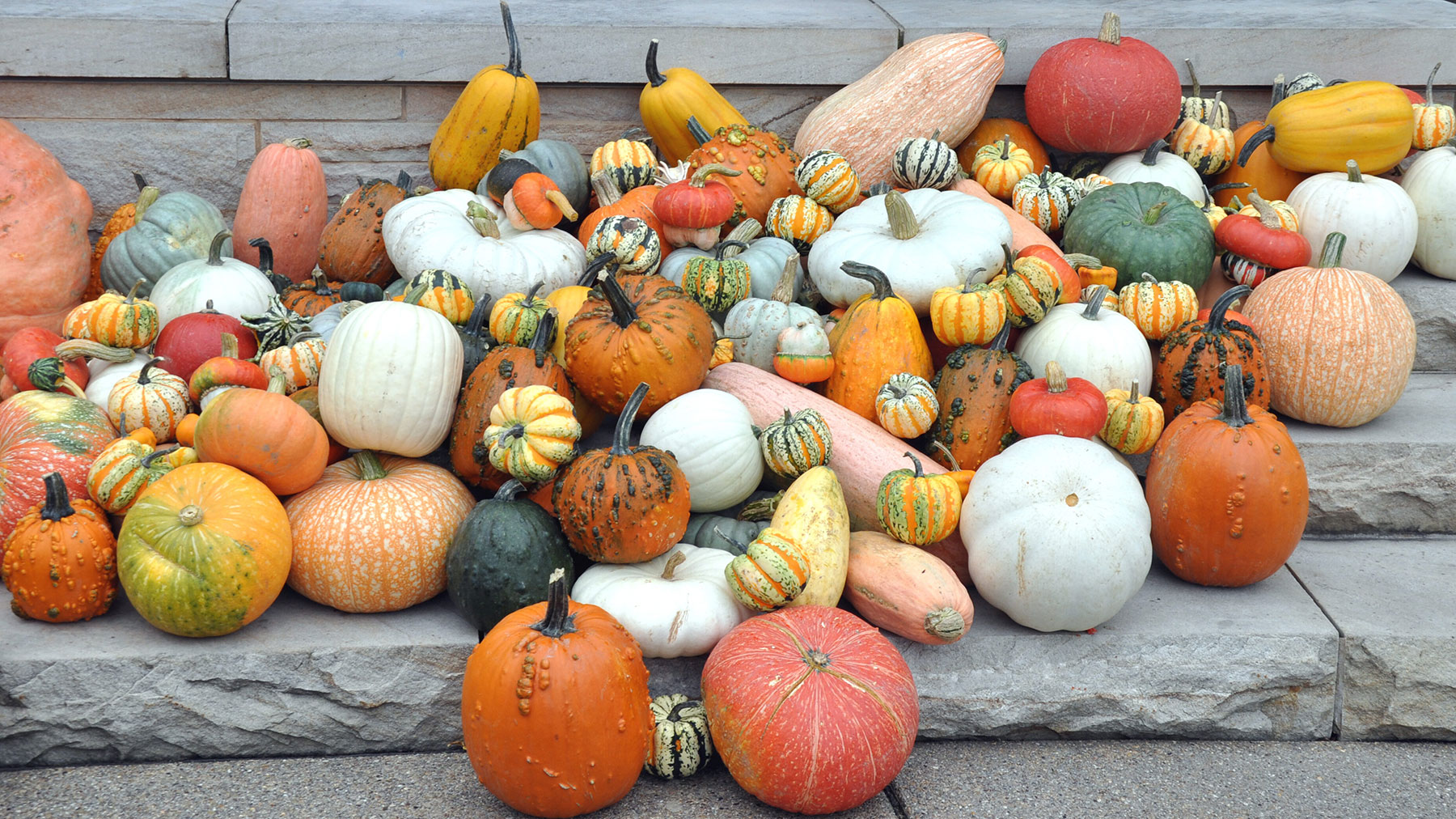
The Arboretum is crazy for cucurbits and celebrates them every autumn by livening up our seasonal displays and hosting our annual Pumpkin Fest that all are welcome to attend each October! The colorful bounty that you may see when strolling the gardens this fall showcases the Cucurbitaceae family, which includes squash, cucumbers, and melons. Cucurbitaceae consists of roughly 975 species of plants across 98 genera, utilized for their agricultural and commercial value as well as their ornamental qualities. Members of this family are primarily herbaceous annuals (sometimes biennial or perennial) and are sensitive to freezing temperatures. They are fast growing and will form a long vine, with most species having white or yellow unisex flowers.
The Cucurbita genus includes pumpkins and gourds ,which, botanically speaking, are all types of squash. However, not all squash are called pumpkins. Confused yet? Let’s dive in more.
Pumpkins originated in North and Central America over 9,000 years ago, and the common name, pumpkin, that is widely used today, is derived from the Greek work “pepon,” meaning large melon. Cucurbita maxima, C. moschata, and C. pepo are the most well-known squash species. They are often referred to as pumpkins or winter squash along with other well-known favorites such as butternut and acorn squash. Winter squash generally ripen in the fall and usually have thick skins that aren’t normally consumed. The fruit in most species is a fleshy berry with a tough rind and contains many flat seeds. They come in a variety of shapes, textures, sizes, and colors. Pumpkins are often rounder and larger (U.S. record of over 1,400 pounds) than many other types of squash and have a sturdier and more jagged stem. They also have a longer shelf life. Pumpkins are the squash most often used for carving, decorating, and baked desserts, while other squash members typically have a creamier and slightly nutty flavor that makes them perfect for many other culinary applications. Summer squash (think zucchini, delicata, pattypan, crookneck, etc.) on the other hand, ripen in the summer, are smaller (under 5 pounds), and have thinner and more tender skin with a softer and lighter stem. Summer squash don’t usually need to be peeled or prepped as much before cooking, and in many cases can be eaten raw. These squash also tend to have a much shorter shelf life than winter squash, usually lasting less than 2 weeks.
Squash has long been a vital food source for the indigenous peoples of the western hemisphere and is believed to be the oldest cultivated food crop in North America. It was grown even before the other crops (corn and beans) that make up the “Three Sisters” planting system. The large squash leaves shaded the soil nearby, protecting these other crops, thereby helping to retain moisture and decrease weed pressure. In general, most cucurbits have low to moderate nutrient content, but winter squash tend to be the highest in fiber, beta-carotene, magnesium, vitamin A, and potassium. Also, don’t forget about the seeds! These are also rich in magnesium, zinc, and phytoestrogens which can help support hormone balance, thyroid function, and blood sugar levels among many other benefits.
Each season, our horticulture team selects, grows, and harvests all of our decorative pumpkins and gourds along with the help of our dedicated volunteers! Depending on the year, this also includes growing our own carving pumpkins to give away to the public so that they can be carved and entered into our jack-o’-lantern contest during our Pumpkin Fest. As you stroll through the Arboretum’s gardens this fall, take note of the diversity of squash included in our seasonal displays, and see if you can recognize the characteristics between species!
What’s on Display?
Cucurbita argyrosperma subsp. argyrosperma ‘Autumn Colors Cushaw’
 This tri-colored hybrid cushaw squash averages around 4–10 pounds, but can grow even bigger, and is great for decorating or baking or cooking.
This tri-colored hybrid cushaw squash averages around 4–10 pounds, but can grow even bigger, and is great for decorating or baking or cooking.
Cucurbita maxima ‘Big Moose’
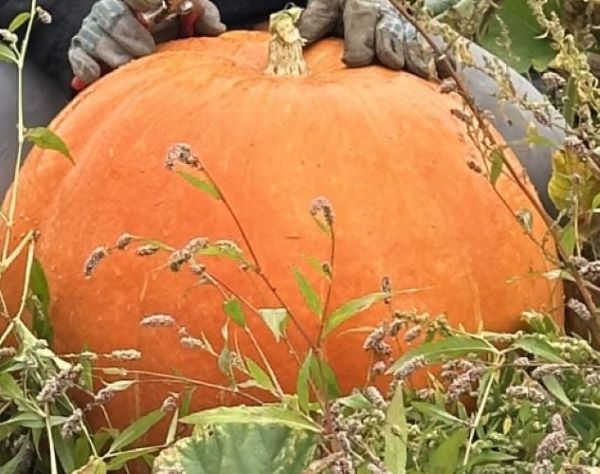 These giant orange-red pumpkins are eye-catching with lightly defined ribs that may develop a tan-colored highlight. If you’re looking for a sizable carving pumpkin or something to fill an expansive display, this variety tops out between 50 and 125 pounds!
These giant orange-red pumpkins are eye-catching with lightly defined ribs that may develop a tan-colored highlight. If you’re looking for a sizable carving pumpkin or something to fill an expansive display, this variety tops out between 50 and 125 pounds!
Cucurbita maxima ‘Blue Ballet’
 A hubbard squash, ‘Blue Ballet’ is small and sports smooth, blue-gray skin. The flesh is fiberless and sweet. It’s an excellent addition to decorations or great for desserts.
A hubbard squash, ‘Blue Ballet’ is small and sports smooth, blue-gray skin. The flesh is fiberless and sweet. It’s an excellent addition to decorations or great for desserts.
Cucurbita maxima ‘Flat Stacker’
 A hybrid derived from the ‘Flat White Boer’ variety, these pumpkins have deep ribbing and a distinctive squatted shape. They typically weigh 10 to 17 pounds with short stems. They are ivory-colored and are perfect for displays. The flesh is sweet with nutty undertones, perfect for many different culinary dishes.
A hybrid derived from the ‘Flat White Boer’ variety, these pumpkins have deep ribbing and a distinctive squatted shape. They typically weigh 10 to 17 pounds with short stems. They are ivory-colored and are perfect for displays. The flesh is sweet with nutty undertones, perfect for many different culinary dishes.
Cucurbita maxima ‘Jarrahdale’
 Drum-shaped and slate-gray, Jarrahdale is an attractive squash with heavy, rounded ribs. The sweet and thick flesh is great for roasting and baking. This is a variety that will store for a long time though the winter months.
Drum-shaped and slate-gray, Jarrahdale is an attractive squash with heavy, rounded ribs. The sweet and thick flesh is great for roasting and baking. This is a variety that will store for a long time though the winter months.
Cucurbita maxima ‘Marina di Chioggia’
 This sometimes-bumpy pumpkin has deep ridges and comes in colors ranging from dark green to aquamarine. Fruits can grow to be 15 pounds and are known for their substantial flesh that bears a sweet, moist, and rich texture, perfect for pies and savory creations such as ravioli and gnocchi!
This sometimes-bumpy pumpkin has deep ridges and comes in colors ranging from dark green to aquamarine. Fruits can grow to be 15 pounds and are known for their substantial flesh that bears a sweet, moist, and rich texture, perfect for pies and savory creations such as ravioli and gnocchi!
Cucurbita maxima ‘One Too Many’
 Beautifully unique, ‘One Too Many’ is light cream to antique white in color with orange-red veining. They will range in shape, typically round, slightly flat, oblong, or a combination. They are commonly used in fall displays.
Beautifully unique, ‘One Too Many’ is light cream to antique white in color with orange-red veining. They will range in shape, typically round, slightly flat, oblong, or a combination. They are commonly used in fall displays.
Cucurbita maxima ‘Polar Bear’
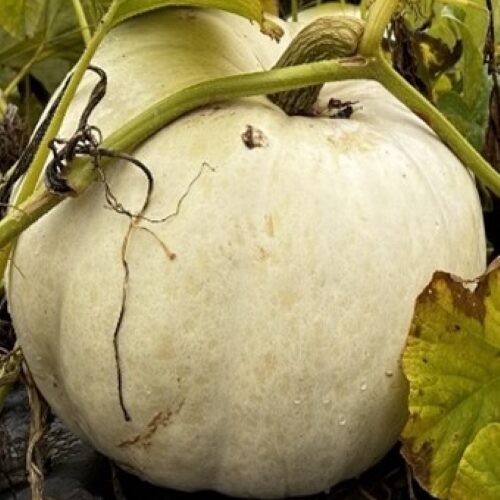 An extra-large pumpkin, ‘Polar Bear’ retains its white color after maturity in decorative displays. It will typically weigh 30 to 65 pounds, but in some cases can exceed 100 pounds. It is a wonderful accent in fall displays.
An extra-large pumpkin, ‘Polar Bear’ retains its white color after maturity in decorative displays. It will typically weigh 30 to 65 pounds, but in some cases can exceed 100 pounds. It is a wonderful accent in fall displays.
Cucurbita maxima ‘Popcorn’
 This fun pumpkin boasts a creamy white-yellow color and is covered in textured “popcorn” warts! Sturdy vines produce medium-sized pumpkins with dark green stems, which are great for fall décor or a unique twist on a carving pumpkin.
This fun pumpkin boasts a creamy white-yellow color and is covered in textured “popcorn” warts! Sturdy vines produce medium-sized pumpkins with dark green stems, which are great for fall décor or a unique twist on a carving pumpkin.
Cucurbita maxima ‘Porcelain Doll’
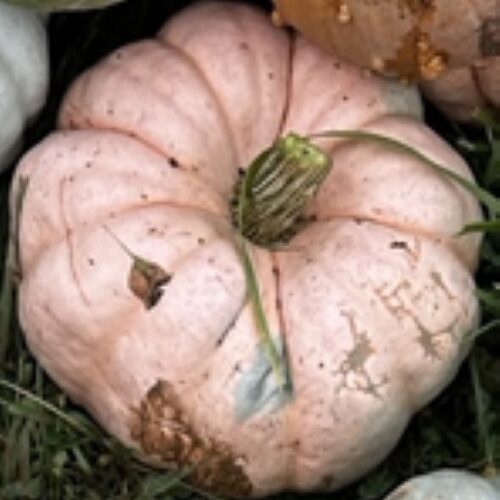 These pumpkins are lumpy, deeply ridged, blocky, and can weigh up to 20 pounds. They’re pale peachy-pink and deer-resistant, and their vines have lots of foliage that’s disease-resistant. The orange flesh is sweet and has delicate honey notes, perfect for pies, soups, and many other recipes.
These pumpkins are lumpy, deeply ridged, blocky, and can weigh up to 20 pounds. They’re pale peachy-pink and deer-resistant, and their vines have lots of foliage that’s disease-resistant. The orange flesh is sweet and has delicate honey notes, perfect for pies, soups, and many other recipes.
Cucurbita maxima ‘Rouge Vif D’ Etampes’
 This is a highly ornamental heirloom variety. Its vibrant color and shape add a sense of whimsy to a display. Also known as ‘Cinderella,’ this variety was the most popular pumpkin in Parisian markets in the late 1800’s. Weighing in at up to 20 pounds each, it is often used for soups, pies, and other creations.
This is a highly ornamental heirloom variety. Its vibrant color and shape add a sense of whimsy to a display. Also known as ‘Cinderella,’ this variety was the most popular pumpkin in Parisian markets in the late 1800’s. Weighing in at up to 20 pounds each, it is often used for soups, pies, and other creations.
Cucurbita maxima ‘Sibley’
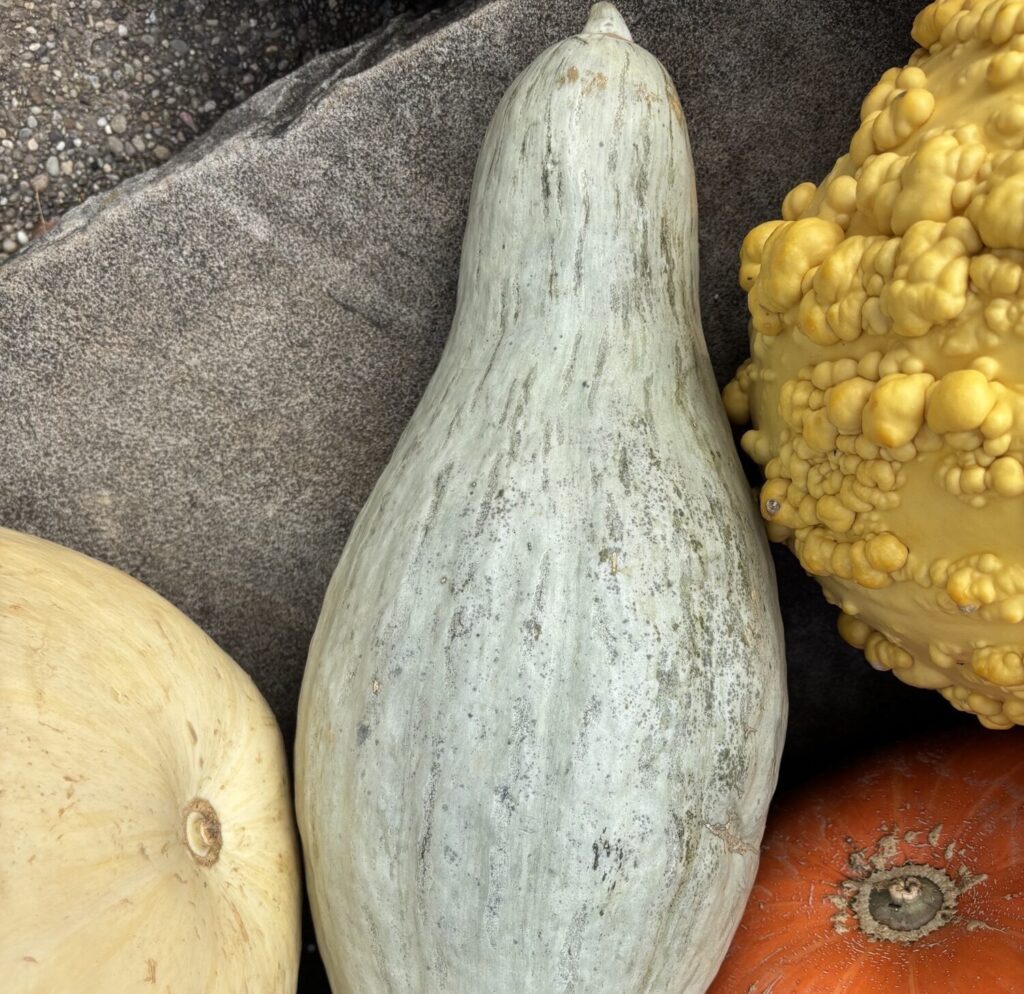 This heirloom squash is also known as ‘Pike’s Peak’ and is celebrated for its top-tier flavor. Slate-blue oblong, teardrop-shaped fruit weighs in between 6 and 8 pounds and contains thick and sweet orange flesh.
This heirloom squash is also known as ‘Pike’s Peak’ and is celebrated for its top-tier flavor. Slate-blue oblong, teardrop-shaped fruit weighs in between 6 and 8 pounds and contains thick and sweet orange flesh.
Cucurbita maxima ‘Strawberry Crown’
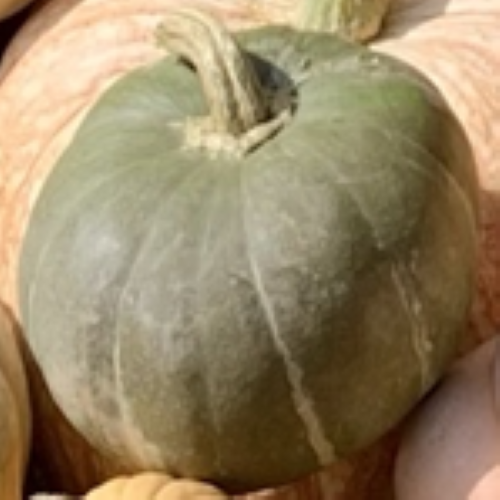 This variety was originally found in Brazil. They are an early grower and develop a gray-brown color that turns bluish or pinkish. The ribs are subtle with bright tiger stripes along them. ‘Strawberry Crown’ is not very sweet, so it’s best used for soups and stews.
This variety was originally found in Brazil. They are an early grower and develop a gray-brown color that turns bluish or pinkish. The ribs are subtle with bright tiger stripes along them. ‘Strawberry Crown’ is not very sweet, so it’s best used for soups and stews.
Cucurbita moschata ‘Long Island Cheese’
 Originating from Long Island, NY, ‘Long Island Cheese’ is an old species of heirloom. They are flat and squat in shape, like a wheel of cheese, and have thick ribbing. The tan-colored pumpkin develops a very thick rind that protects the flesh, which can be used for pies, pastries, and other fall treats.
Originating from Long Island, NY, ‘Long Island Cheese’ is an old species of heirloom. They are flat and squat in shape, like a wheel of cheese, and have thick ribbing. The tan-colored pumpkin develops a very thick rind that protects the flesh, which can be used for pies, pastries, and other fall treats.
Cucurbita moschata ‘Musquee de Provence’
 These beautiful large, flat pumpkins are shaped like wheels of cheese with many ridges and lobes. The skin is a light tan-peach-brown color when mature with hints of green when unripe. Getting up to 20 pounds, the thick flesh takes on a great flavor.
These beautiful large, flat pumpkins are shaped like wheels of cheese with many ridges and lobes. The skin is a light tan-peach-brown color when mature with hints of green when unripe. Getting up to 20 pounds, the thick flesh takes on a great flavor.
Cucurbita moschata ‘Pennsylvania Dutch Crookneck’
 ‘Pennsylvania Dutch Crookneck’ lives up to its name. The butternut-type squash is shaped like a turkey neck, long and curved. It is commonly used for decorations, but it has sweet, creamy, smooth flesh that is tasty.
‘Pennsylvania Dutch Crookneck’ lives up to its name. The butternut-type squash is shaped like a turkey neck, long and curved. It is commonly used for decorations, but it has sweet, creamy, smooth flesh that is tasty.
Cucurbita moschata ‘Seminole’
 This wild squash variety out of Florida is a pumpkin with rich flavor and deep historical roots, and it is well-liked in the deep South, where it can tolerate intense heat. This squash averages between 3 to 10 pounds and has a tan colored skin similar to that of a butternut.
This wild squash variety out of Florida is a pumpkin with rich flavor and deep historical roots, and it is well-liked in the deep South, where it can tolerate intense heat. This squash averages between 3 to 10 pounds and has a tan colored skin similar to that of a butternut.
Cucurbita pepo Autumn Wings Gourd Mix
 This brightly colored gourd mix is purely ornamental and they are commonly displayed in groupings as they weigh under a pound each. Winged and warted in various shapes, these would work perfectly in a cornucopia or harvest decor tablescape.
This brightly colored gourd mix is purely ornamental and they are commonly displayed in groupings as they weigh under a pound each. Winged and warted in various shapes, these would work perfectly in a cornucopia or harvest decor tablescape.
Cucurbita pepo ‘Blaze’
 Brightly colored, striped, and perfectly packaged into a compact, slightly flattened package, ‘Blaze’ is a popular ornamental choice known for its high yield and disease resistance.
Brightly colored, striped, and perfectly packaged into a compact, slightly flattened package, ‘Blaze’ is a popular ornamental choice known for its high yield and disease resistance.
Cucurbita pepo ‘Carnival’
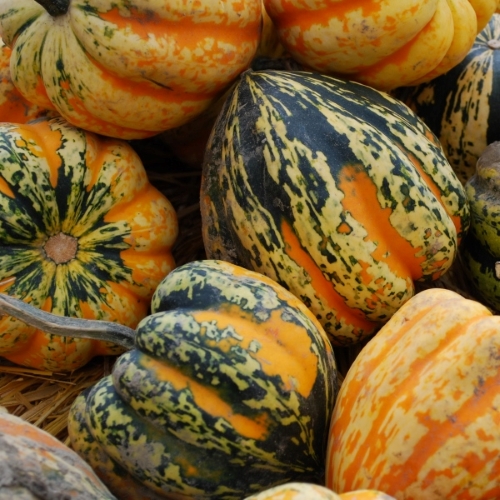 Carnival is colorful and adorable with confetti-like flecks of dark green, light green, orange, and yellow. It is popular for harvest decoration and only weighs in at about 1 ½ pounds.
Carnival is colorful and adorable with confetti-like flecks of dark green, light green, orange, and yellow. It is popular for harvest decoration and only weighs in at about 1 ½ pounds.
Cucurbita pepo ‘Hot Chocolate’
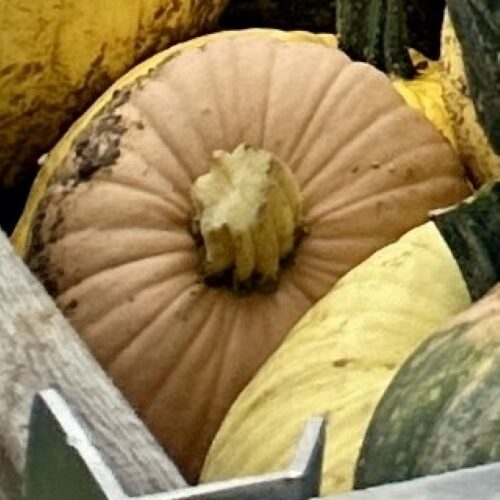 This is an ornamental pumpkin with a distinct caramel-tan color reminiscent of hot cocoa. Long vines give way to 5- to 8-pound fruits perfect for display!
This is an ornamental pumpkin with a distinct caramel-tan color reminiscent of hot cocoa. Long vines give way to 5- to 8-pound fruits perfect for display!
Cucurbita pepo ‘Igor’
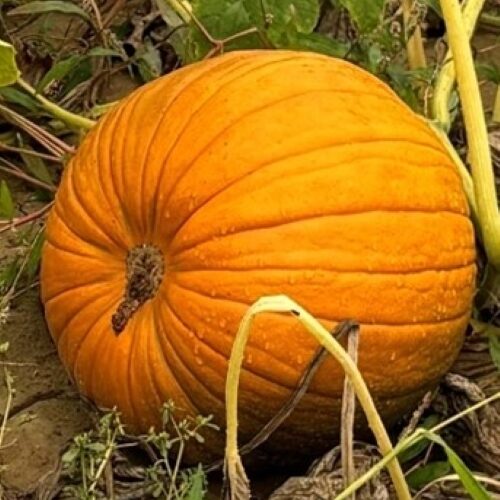 This is a great Halloween jack-o’-lantern with dark orange skin with deep ribbing. Tall and lurking, this variety weighs up to 35 pounds and creates a foreboding look on display!
This is a great Halloween jack-o’-lantern with dark orange skin with deep ribbing. Tall and lurking, this variety weighs up to 35 pounds and creates a foreboding look on display!
Cucurbita pepo ‘Jill Be Little’
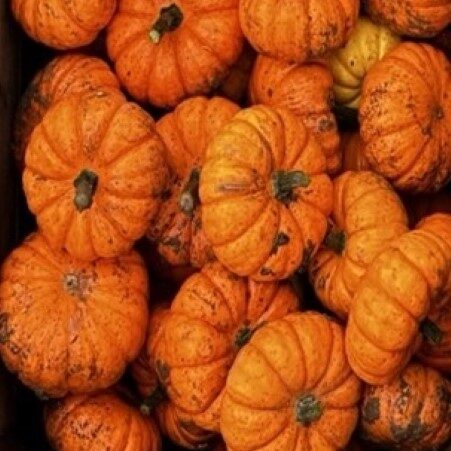 A disease-resistant mini ornamental pumpkin, ‘Jill-Be-Little’ is flat in shape with wide, deep ribs and a soft orange color. They are great for tabletop and window displays, as they only measure 3 to 4 inches in diameter, and can serve as a finishing touch for any fall decoration or craft project.
A disease-resistant mini ornamental pumpkin, ‘Jill-Be-Little’ is flat in shape with wide, deep ribs and a soft orange color. They are great for tabletop and window displays, as they only measure 3 to 4 inches in diameter, and can serve as a finishing touch for any fall decoration or craft project.
Cucurbita pepo ‘Mellow Yellow’
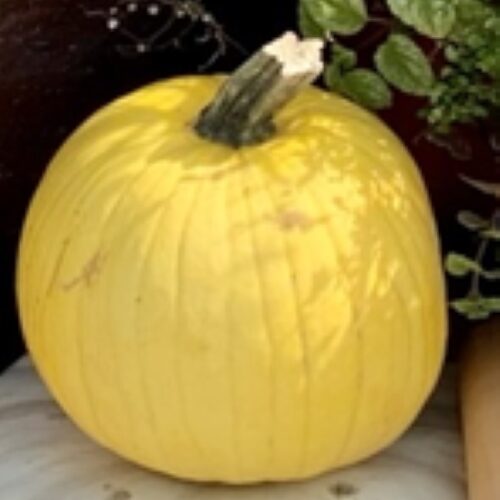 A newer variety, ‘Mellow Yellow’ is round and blocky in shape, weighing up to 22 pounds. The flesh is stringy and less desirable but is still edible. What’s striking about this pumpkin is its bright lemon-yellow color that will brighten up any fall display.
A newer variety, ‘Mellow Yellow’ is round and blocky in shape, weighing up to 22 pounds. The flesh is stringy and less desirable but is still edible. What’s striking about this pumpkin is its bright lemon-yellow color that will brighten up any fall display.
Cucurbita pepo ‘Secretariat’
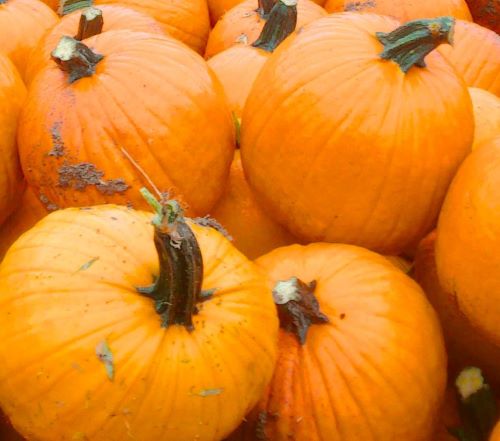 Secretariat is a very deep-orange pumpkin with deep ribbing and a slightly flattened shape. Weighing in at a sturdy 15 pounds, it makes a great carving pumpkin or addition to a display.
Secretariat is a very deep-orange pumpkin with deep ribbing and a slightly flattened shape. Weighing in at a sturdy 15 pounds, it makes a great carving pumpkin or addition to a display.
Lagenaria siceraria
 These are often medium to large gourds with a narrow neck and a bulbous base. They can grow up over a foot tall and a foot in diameter. The lovely green rind eventually turns white or brown when mature. They can make great birdhouses when dried!
These are often medium to large gourds with a narrow neck and a bulbous base. They can grow up over a foot tall and a foot in diameter. The lovely green rind eventually turns white or brown when mature. They can make great birdhouses when dried!

